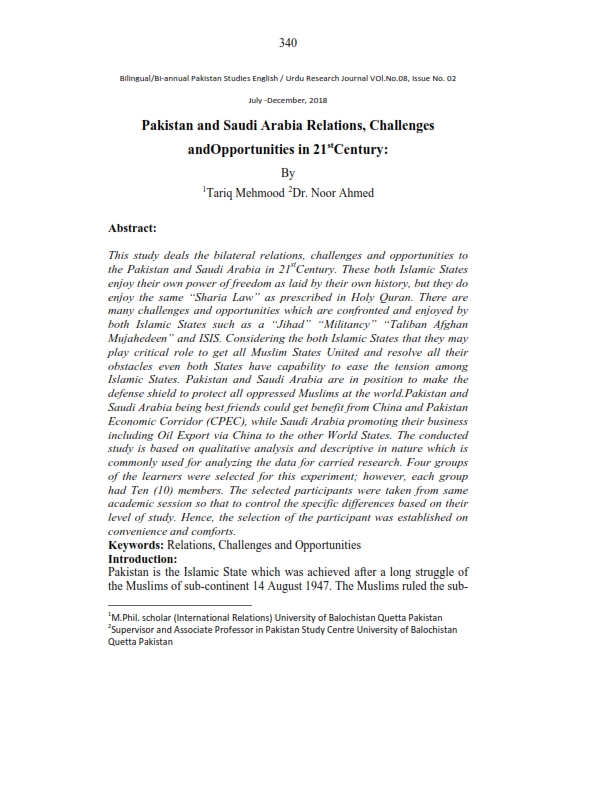Pakistan and Saudi Arabia Relations, Challenges and Opportunities in 21stCentury
Keywords:
Relations, Challenges and OpportunitiesAbstract
This study deals the bilateral relations, challenges and opportunities to
the Pakistan and Saudi Arabia in 21stCentury. These both Islamic States
enjoy their own power of freedom as laid by their own history, but they do
enjoy the same “Sharia Law” as prescribed in Holy Quran. There are
many challenges and opportunities which are confronted and enjoyed by
both Islamic States such as a “Jihad” “Militancy” “Taliban Afghan
Mujahedeen” and ISIS. Considering the both Islamic States that they may
play critical role to get all Muslim States United and resolve all their
obstacles even both States have capability to ease the tension among
Islamic States. Pakistan and Saudi Arabia are in position to make the
defense shield to protect all oppressed Muslims at the world.Pakistan and
Saudi Arabia being best friends could get benefit from China and Pakistan
Economic Corridor (CPEC), while Saudi Arabia promoting their business
including Oil Export via China to the other World States. The conducted
study is based on qualitative analysis and descriptive in nature which is
commonly used for analyzing the data for carried research. Four groups
of the learners were selected for this experiment; however, each group
had Ten (10) members. The selected participants were taken from same
academic session so that to control the specific differences based on their
level of study. Hence, the selection of the participant was established on
convenience and comforts.
References
Akram M. Reversing Strategic ‘Shrinkage.’. Pakistan: Beyond the ‘Crisis
State. (2011):283-304.
Akram, S. M. (2002). The aftermath of September (11, 2001): The
targeting of Arabs and Muslims in America. Arab Studies
Quarterly, 61-118.
Akram, Susan M. "The aftermath of September 11, 2001: The targeting of
Arabs and Muslims in America." Arab Studies Quarterly (2002):
-118.
Alarfaj, Ahmad Abdulrahman. How Saudi Arabian newspapers depicted
the September 11 attacks. Diss. University of Birmingham, (2013).
Bahgat, Gawdat. "Iranian-Saudi Arabia rapprochement: Prospects and
implications." World Affairs 162.3 (2000): 108-115.
Burke, S.M. and Ziring, L., (1990). Pakistan's foreign policy: an historical
analysis. Oxford University Press, USA.
Commins D.The Wahhabi Mission and Saudi Arabia. IB Tauris; (2009)
Mar 30.
Commins, David. The Wahhabi Mission and Saudi Arabia.IB Tauris,
(2009).
Delong-Bas, N. J. (2008). Wahhabi Islam: from revival and reform to
global jihad. Oxford University Press.
Delong-Bas, Natana J. Wahhabi Islam: from revival and reform to global
jihad. Oxford University Press, (2008).
Duffield, John, and Peter Dombrowski. Balance sheet: The Iraq War and
US national security. Stanford University Press, (2009).
Galea, Sandro, et al. "Psychological sequelae of the September 11 terrorist
attacks in New York City." New England Journal of
Medicine 346.13 (2002): 982-987.
Galtung, Johan. "Violence, peace, and peace research." Journal of peace
research 6.3 (1969): 167-191.
Gartenstein-Ross, D. (2010). Religious militancy in Pakistan’s military
and Inter-Services Intelligence Agency. The Afghanistan-Pakistan
Theater, p.29.
Gartenstein-Ross, Daveed."Religious militancy in Pakistan’s military and
Inter-Services Intelligence Agency." The Afghanistan-Pakistan
Theater (2010): 29.
Grigsby, Hope, and Brandon Friedman."Women to Drive Movement”.
Grumet, Tali R. New Middle East Cold War: Saudi Arabia and Iran's
rivalry. Diss. University of Denver, (2015).
Grummet, Tali R. New Middle East Cold War: Saudi Arabia and Iran's
rivalry. Diss University of Denver, (2015).
Hampton, Kelsey. "Doctrinally and Politically opposed on the Battlefield
in Syria: Iran and Saudi Arabia’s Cold War in the Middle East."
(2014).
Haqqani, H. (2010). Pakistan: Between mosque and military. Carnegie
Endowment.Haqqani,
How Long Can Pakistan Avoid Joining Saudi Arabia-Led Attacks on
Yemen’s Houthis? ZofeenEbrahim @zofeen28 | April 6, (2015).
Idrees, R. N., Abbasi, A. S., & Waqas, M. (2013). Systematic Review of
Literature on
Iji, Tetsuro. "The UN as an International Mediator: From the Post–Cold
War Era to the Twenty-First Century." Global Governance: A
Review of Multilateralism and International Organizations 23, no.
(2017): 83-100.
Jamal, Amaney."Civil liberties and theorization of Arab and Muslim
Americans." Race and Arab Americans before and after 9.11
(2008): 114-30.
Jamal, Amina. "Piety, transgression, and the feminist debate on Muslim
women: Resituating the victim-subject of honor-related violence
from a transnational lens." Signs: Journal of Women in Culture and
Society 41.1 (2015): 55-79.
Jones, Bruce, Richard Gowan, and Jake Sherman. "Building on Brahimi:
Peacekeeping in an era of strategic uncertainty." New York
University (2009).
Keddie, Nikki R., and Yann Richard. Modern Iran: Roots and results of
revolution. Yale University Press, (2006).
Kiran N. Political Stability in Pakistan: Regionalism and Role of Cabinet
(1947-1958). Pakistan Vision. (2012) Jun 1; 13(1):207.
Lister, Charles. "Profiling the Islamic state." Brookings Doha Center
Analysis Paper 13 (2014): 17.
Mabon, Simon. "The Battle for Bahrain: Iranian‐Saudi Arabia
Rivalry." Middle East Policy 19.2 (2012): 84-97.
Mayer, Ann Elizabeth. "Rhetorical strategies and official policies on
women's rights: the merits and drawbacks of the New World
hypocrisy." Al-Raida Journal (1998): 12-21.
Mayer, Ann Elizabeth. "Rhetorical strategies and official policies on
women's rights: the merits and drawbacks of the New World
hypocrisy." Al-Raida Journal (1998): 12-21.
Mellahi, Kamel. "The effect of regulations on HRM: private sector firms
in Saudi Arabia." The International Journal of Human Resource
Management 18.1 (2007): 85-99.
O'Brien LB. The evolution of terrorism since (9/11). FBI L. Enforcement
Bull... 2011; 80:3.
O'Brien, L.B. (2011). The evolution of terrorism since 9/11. FBI L.
Enforcement Bull., 80, p.3.
Razvi M. Pak-Saudi Arabian Relations: An Example of Entente Cordiale.
Pakistan Horizon. (1981) Mar 1; 34(1):81-92.
Razvi, Mujtaba. "Pak-Saudi Arabian Relations: An Example of Entente
Cordiale." Pakistan Horizon 34.1 (1981): 81-92.
Razvi, Mujtaba. "Pak-Saudi Arabian Relations: An Example of Entente
Cordiale." Pakistan Horizon 34.1 (1981): 81-92.
Rizvi, H.A., (1982). Gulf Cooperation Council. Pakistan Horizon, 35(2),
pp.29-38.
Rizvi, Hasan-Askari."Gulf Cooperation Council." Pakistan Horizon 35.2
(1982): 29-38.
Schuster, Mark A., et al. "A national survey of stress reactions after the
September (11, 2001), terrorist attacks." New England Journal of
Medicine 345.20 (2001): 1507-1512.
Watts, Barry D. Long-Range Strike: Imperatives, Urgency and Options.
April: Center for Strategic and Budgetary Assessments, (2005).
Workforce Diversity in Pakistan. Middle-East Journal of Scientific
Research, 17(6), 780-790.
Yamani, Maha. Polygamy and law in contemporary Saudi Arabia. Garnet
Publishing Ltd, (2008).



